The Scottish Shelf Model. Part 1: Shelf-Wide Domain
Part 1 of the hydrodynamic model developed for Scottish waters.
5 Model Climatology
5.1 Introduction
The requirement is to produce a one-year climatology run based on climatological forcing, including climatological river forcing, which will represent a typical annual cycle.
The results from the climatology run have been compared with climatological atlas information for temperature, salinity and currents. This has provided a distribution of the typical tidal and residual currents over Scottish Waters which has then been used for particle tracking and to calculate connectivity indices.
In order to derive representative residual flows (driven by tide, wind, density gradients and river discharges) for the model connectivity calculations we wish to look at monthly mean rather than synoptic scale forcing. This includes the prevailing wind, tides, mean river flow and monthly mean boundary and surface forcing for temperature and salinity, which allows the water temperature and salinity to follow the seasonal cycle.
An interesting question which is not explored fully here is to understand how much winter storm events affect the residual flows. It would be of interest to examine the model results using monthly mean forcing for a stormy winter month compared with the mean forcing for the same month. It may be possible to select a representative year to explore storminess, in the same way as has been done for the PFOW wave modelling. However (after some detailed discussion with Marine Scotland) in this case it was decided to ignore the effect of storms. The monthly mean wind-stress was used over a climatological period (typically 30 years), which, while larger than the monthly mean wind speed, will thus underestimate the effect of wind-driven mixing.
5.2 Data
Forcing data
1. AMM daily mean boundary forcing (plus initial conditions) for temperature and salinity were taken from the long-term hindcast carried out by Sarah Wakelin and Jason Holt, over the period 1960-2004.
2. Met forcing data for climatological simulations of the models were obtained from ECMWF ( ERA-40 and ERA-Interim, licence granted). The ERA-interim data cover 1989 - present, and ERA-40 1957 to 2002. These data were processed to derive monthly mean wind-stress, pressures, heating and evaporation minus precipitation for the period 1981-2010, to match the boundary forcing period.
3. River climatology were obtained from 2 sources: (i) a reconstructed river climatology derived by reference to the E-HYPE model (126 Scottish rivers, 1980-2012 provided by the Swedish Meteorological and Hydrological Institute, SMHI), distributed across the 508 G2G river discharge locations for the Scottish mainland, as originally provided by CEH for March 2007 - Sep 2010 (see below) (ii) G2G river climatology (1962-2011, 577 rivers) recently provided by CEH in August 2014 and updated in October 2014.
Validation data: Temperature and salinity climatology
1. Temperature and salinity observations are available from the ICES dataset ( http://www.ices.dk/marine-data/data-portals/Pages/ocean.aspx) gridded and averaged for 1960-2004 (45 years) by Jason Holt. Note that this is not identical to Berx and Hughes (2009) who presented a 30-year climatology. Temperature and salinity data are also available from the NOAA/ NDBC World Ocean Atlas (2013; http://www.nodc.noaa.gov/OC5/woa13/) based on over 100 years of observations. These data have been interpolated onto grids with varying resolution. Here we used 0.25° resolution temperature and salinity for the Greenland and Nordic Seas for qualitative comparisons, referred to as WOA.
2. The AMM model results (1960-2004; Holt et al., 2009) have also been used for comparison (see above).
5.3 Methodology
1. ERA-Interim data were accessed from BADC for derivation of the climatological forcing. Met Office UM data were not available for an extended period, thus were not suitable.
2. Initially CEH river data were only available for the Scottish mainland and there was no climatology provided, so for the initial climatology run, a reconstructed river climatology was used. Later, data were provided for the extra rivers in Northern Ireland and Shetland and a 50-year river climatology was also provided. The method for deriving the reconstructed climatology for the 508 G2G rivers was to apply a climatological mean to each river, scaled by its fraction of the mean discharge, taken from the 2007-2010 dataset. The climatological mean was taken from the E-HYPE data for 1981-2010 i.e. summing all the rivers in the E-HYPE database. The seasonal cycle was retained by taking the daily mean for each day in the year across the 30 years. Although the distribution between east-, north- and west- flowing rivers may vary somewhat from year to year the inter-annual variability appears to be only O(10%). The daily data were de-trended before averaging. Further smoothing was carried out in the time domain (using a 31-day running mean), as there is a lot of variability at the daily to monthly time-scale. The total daily climatological discharge for each river dataset is shown in Figure 5-1. It may be seen that the climatology for AMM and E-HYPE is rather similar, whereas the 3-year-averaged G2G data retain more variability due to the shorter duration. The resultant daily discharges, for the top 10 G2G rivers (all on the Scottish mainland), are shown in Figure 5-2, comparing the reconstructed (red) with CEH-provided climatology discharges (black). The largest discharge (shown as heavier lines) is for the Tay, being almost twice the magnitude of the next largest river. The Tay is the longest river in Scotland, with the largest catchment area. It is interesting to note that the CEH climatology is quite similar to the reconstruction, with a slight phase shift.
3. A 1-year climatological model run of the shelf model was carried out using the following forcing:
a. Initial and boundary conditions were taken from a mean of the AMM climatology run.
b. The tides were included as a mean tidal year.
c. The met forcing was derived as monthly means, which were then linearly interpolated to 6-hourly smoothed forcing data for each grid-point of FVCOM i.e. mean February data were applied at the middle of February; then mean March data were applied mid-March etc., with time-interpolation between. The spatial interpolation was carried out by FVCOM in a similar way to the use of UM data for the model hindcast of 2008-2009.
d. The first run of climatology used the reconstructed river data. A second run used the CEH-provided river climatology. The results were very similar except that the nearshore freshwater due the inclusion of the Northern Ireland rivers can be seen.
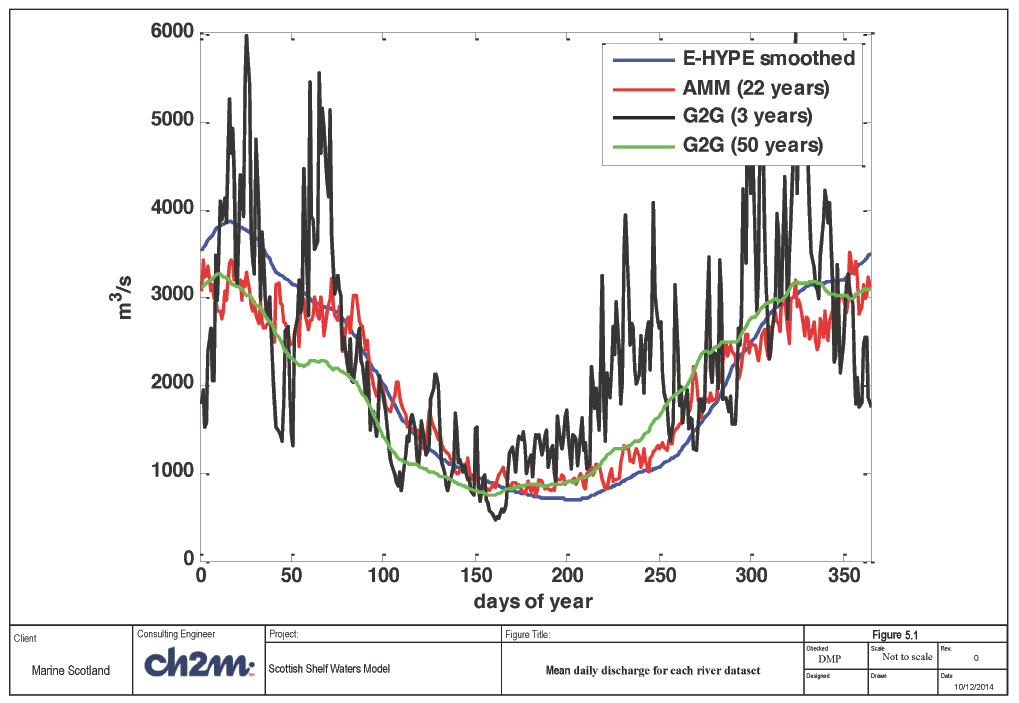
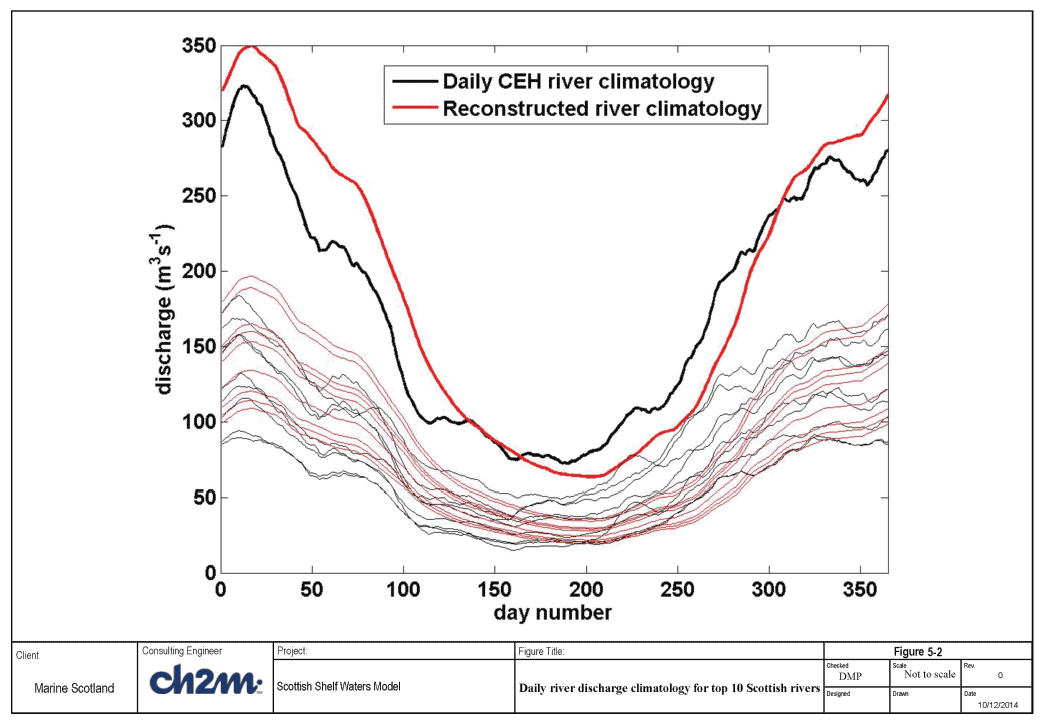
5.4 Results and qualitative comparison with ocean atlas data
It can be seen e.g. from Berx and Hughes (2009) that the maximum and minimum of the SST occur in February and August so these months have been used (Figures 5-3 and 5-4) to show the range of the seasonal cycle. The SST shows good agreement with the World Ocean Atlas (2013) data and the ICES data sets. As well as agreement on SST values, local spatial variations and patterns in SST are correctly predicted by FVCOM, such as the warm SST line North of Scotland in February and the localised cooler patch of SST in East Scottish Waters for August.
Surface salinity comparisons are shown in Figure 5-4 for the three climatology representations. Good agreement is shown for salinity with the World Ocean Atlas and ICES data sets and all three give higher salinity in August compared to February for the North Sea region. FVCOM gives slightly lower salinity compared with the atlas data along the shelf edge, however this difference is marginal.
Mean residual currents are shown in Figure 5-5. In Figure 5-6 some comparative data are shown from OSPAR (2000) and Holt and Proctor (2008). These show general agreement for the magnitude and patterns of the residual circulation.
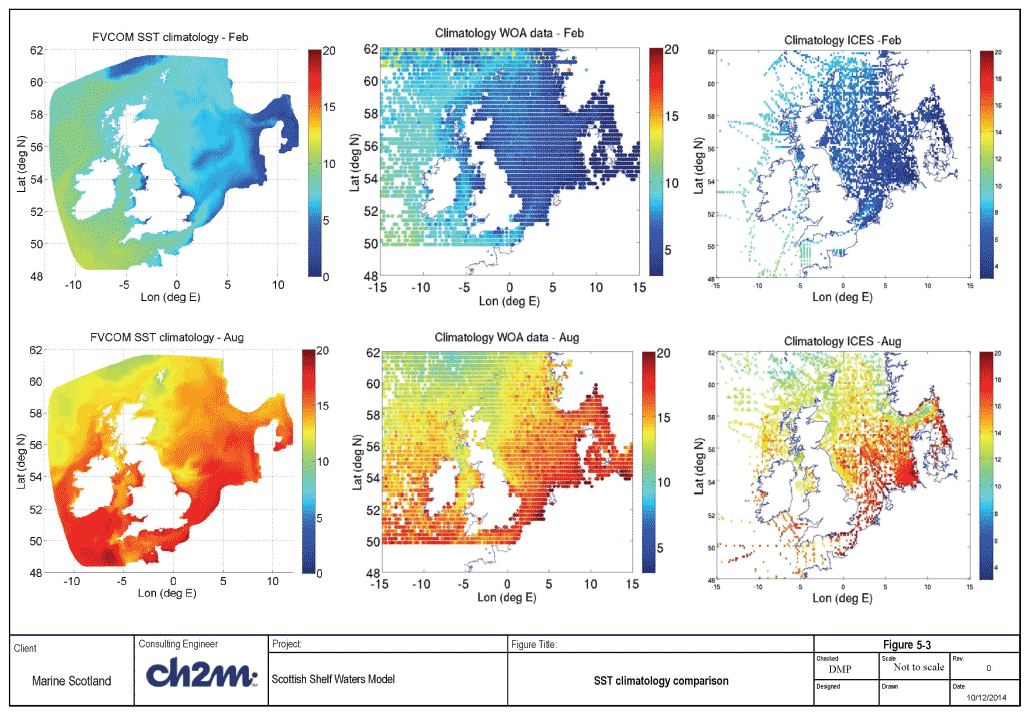
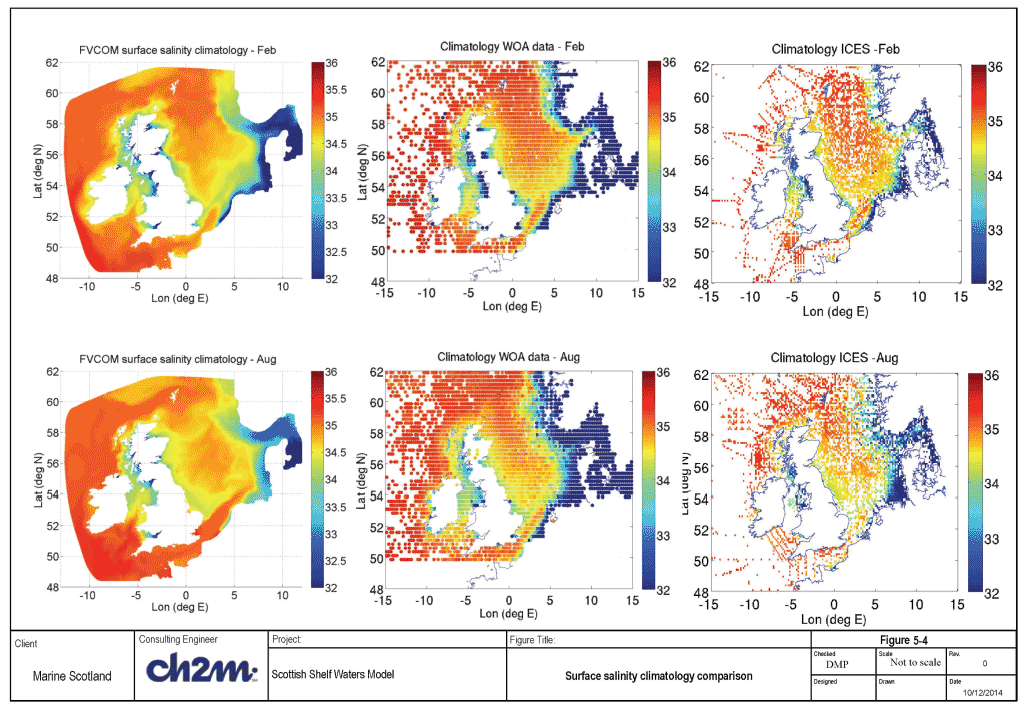
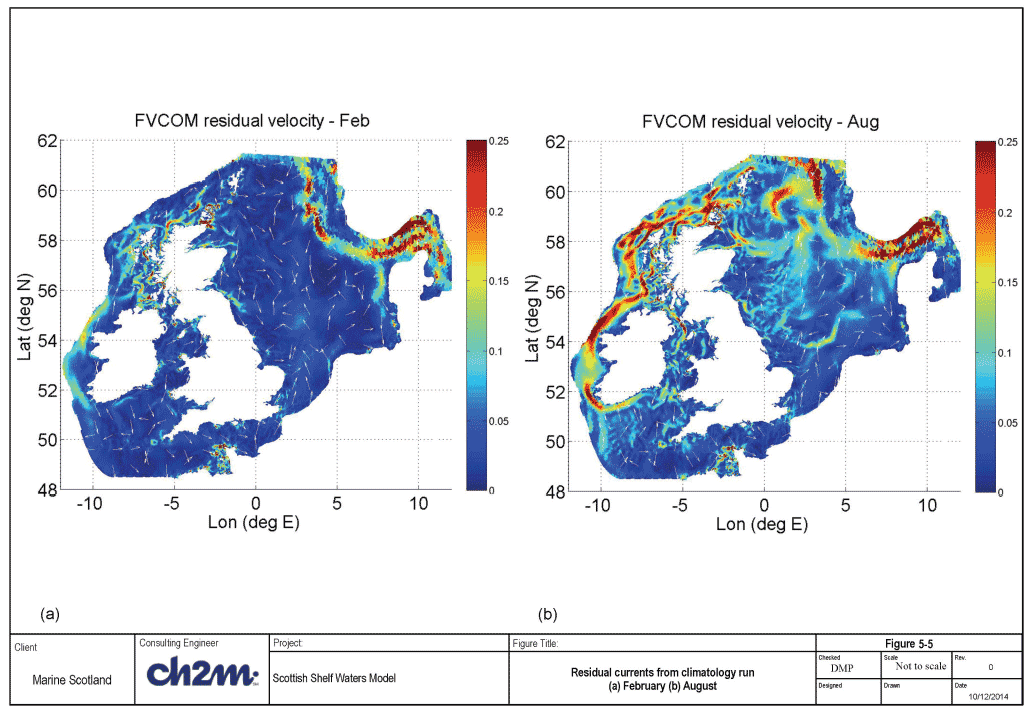
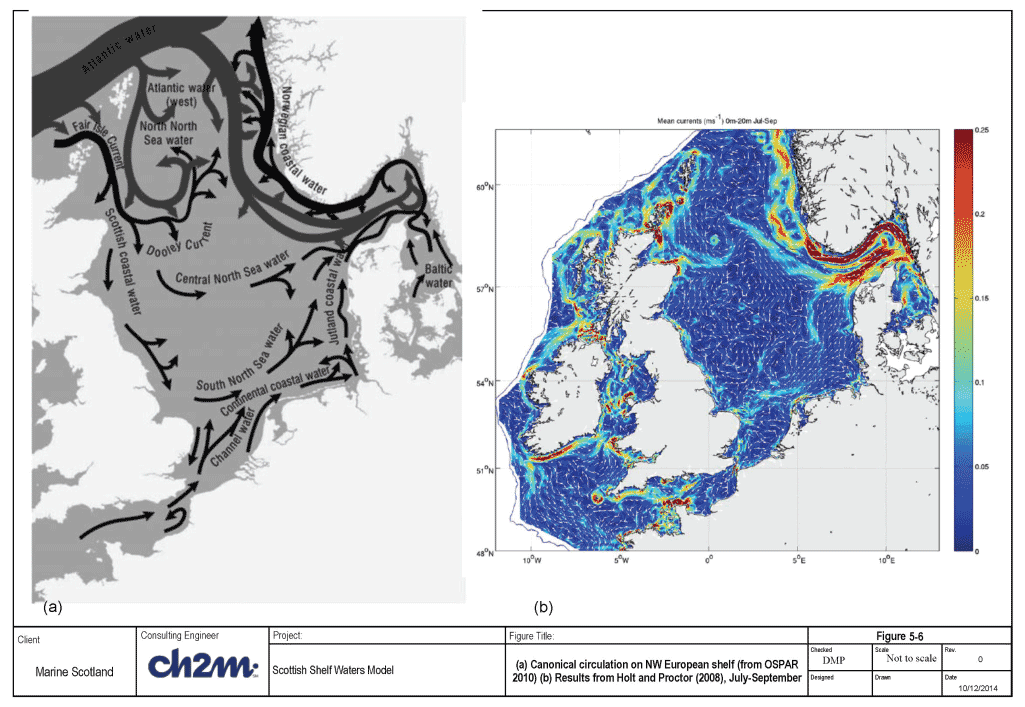
Contact
There is a problem
Thanks for your feedback